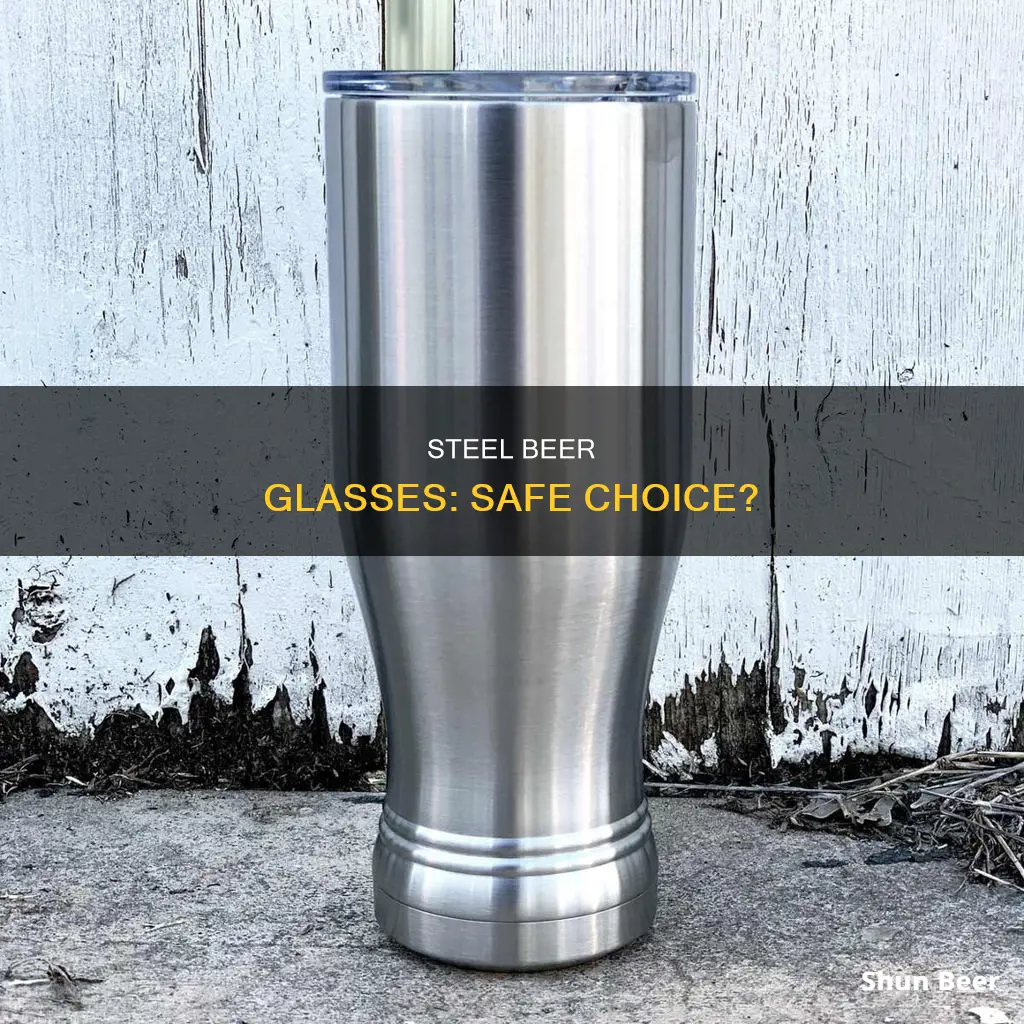
There is much debate about whether it is a good idea to drink beer from a steel glass. While it is technically safe to do so, some argue that it detracts from the drinking experience. Beer is usually served in a transparent glass, allowing the drinker to appreciate the colour and texture of the beer, which can enhance the taste. With a steel glass, the drinker is unable to see the beer, and the proximity of the nose to the steel can impart a metallic smell and taste.
| Characteristics | Values |
|---|---|
| Safety | Drinking beer from stainless steel is safe and will not cause harm to the drinker. |
| Taste | Stainless steel does not affect the taste of beer, but the smell of the metal may cause a perception of a metallic taste. |
| Sight | Beer is usually served in transparent glasses to allow drinkers to see the colour and foam. Stainless steel mugs deprive drinkers of this experience. |
| Temperature | Stainless steel keeps beer cold for longer than glass. |
What You'll Learn

Stainless steel glasses exist
Stainless steel glasses do exist and are readily available. They are typically used for outdoor activities such as camping and festivals, and they are also marketed as being suitable for children. These steel glasses are often stackable and shatterproof, and some are insulated to keep drinks cold.
There are a variety of stainless steel drinking vessels available, including cups, mugs, and tumblers. Some are designed specifically for beer, with some products advertised as "beer steins" or "beer tumblers." Many of these products are also BPA-free, meaning they do not contain bisphenol A, an industrial chemical sometimes used in the production of certain plastics.
While stainless steel glasses do exist, there are differing opinions on whether they are suitable for drinking beer. Some sources claim that drinking beer from a stainless steel glass can affect the drinking experience negatively. This is because the beer's appearance, an important factor in the overall sensory experience, cannot be appreciated when served in an opaque steel vessel. Additionally, the proximity of the drinker's nose to the steel container can result in a metallic smell and an unpleasant taste.
However, stainless steel is used extensively in brewing beer, and it does have some advantages over traditional glassware. Stainless steel keeps beer colder for longer, and it is also shatterproof, making it a safer option in certain settings.
Beer and Keflex: Safe Mix or Health Risk?
You may want to see also

Beer's colour is important
While it is possible to drink beer from a steel glass, it is not recommended. Beer is a drink that appeals to almost all the senses, and serving it in a steel glass deprives the drinker of the visual aspect of the drinking experience. The colour of a beer is important, as it is integral to our experience of food and drink. When beer is poured into a clear glass, the colour is the first thing a drinker will notice.
The colour of beer is determined by several factors, including the grain used, the length of the drying process, the temperature of the kiln, and the presence of hops or yeast. The longer the drying process and the higher the temperature, the darker the beer will be. The grain used to make the beer is the strongest colouring agent, and these grains are coloured by melanin, resulting in a rust-red pigmentation. This colour can be changed through specific chemical processes, such as Maillard reactions and caramelization reactions. Maillard reactions occur when amino acids are linked to sugars, usually through intense heat, and are responsible for the toasty flavours found in beer. Caramelization, on the other hand, occurs when sugar is heated until it breaks apart, resulting in a caramel-like flavour. The longer the caramelization process, the darker the beer becomes.
The colour of beer can also change over time, as beer ages, particles in suspension, such as yeast and polyphenols, begin to fall to the bottom of the vessel, causing the beer to reflect less light and appear darker. Oxidation can also affect the colour of beer, as oxygen interacts with the beer, causing it to degrade and darken, similar to how a banana turns brown when left out.
While the colour of beer may not be a reliable indicator of flavour, it still plays a crucial role in the overall drinking experience. It conjures up expectations of the flavour and creates a certain atmosphere. For example, a bright golden beer may evoke expectations of refreshment and sunny days, while a reddish-black beer may lead one to expect malty, roasted flavours and a cosy fireplace. Therefore, brewers pay close attention to achieving the right hues for their creations.
Beer and COPD: What's Safe to Drink?
You may want to see also

Stainless steel doesn't affect the taste of beer
There is a lot of debate about whether drinking beer from a stainless steel glass is safe, and if it affects the taste of the beer. However, stainless steel does not affect the taste of beer.
Firstly, it is important to note that beer is brewed using equipment made from stainless steel. This is because stainless steel does not add any unusual flavours or scents to the beer. If stainless steel affected the taste of beer, it would be noticeable during the brewing process.
However, when drinking from a stainless steel mug, your nose is in close proximity to the vessel, and you may smell a whiff of metal. Smell and taste are closely linked, and so when you smell the metal container, it may seem as though your beer also tastes metallic, which can be unpleasant. This is not the case, as stainless steel does not dissolve into the beer and alter its flavour.
The reason for the metallic taste is that your senses are reacting to the effects of the metal. The iron from the stainless steel is reacting with your skin or lips to create a metallic taste or odour. This is not caused by the stainless steel, but by your body's reaction to the metal.
Additionally, stainless steel is covered in a thin, transparent layer of chromium oxide. This layer is inert, meaning it does not react with anything. It doesn't dissolve in water, and it doesn't conduct electricity. It follows that it won't dissolve into your beer and affect its taste.
Beer and Chronic Gastritis: What You Need to Know
You may want to see also

Drinking from steel deprives you of sight
Although drinking beer from a steel glass is entirely safe, it does deprive drinkers of one of their most important senses: sight. Beer is a unique beverage that affects almost all the senses, and a lot of the drinking experience comes from the visual cues we get from it.
Being able to see the golden or dark hue with the majestic and velvety foam on top greatly affects how we perceive the drink. Stainless steel mugs deny the drinker this opportunity, and the only thing we see with beer served in a steel mug is the foam that will soon deflate and the grey outer surface of the mug. This is a far cry from the awesome view of the beer's colour that we get from a glass.
The sense of sight also plays a huge role in our perception of taste. When we drink from a steel mug, our nose is in close proximity to the vessel, allowing us to take a whiff of metal. Smell and taste go hand in hand, so when we smell the metal container, it can seem like our beer also has a metallic taste, which can be unpleasant.
There are numerous shapes of beer glasses, and each plays a particular role for each type of beer. A stainless steel mug does not offer the same variety of shapes and designs as a glass, and beer glasses have been the norm since they evolved from the tankard, so it may be difficult to drink beer from a different vessel.
While stainless steel mugs may keep beer cold for longer, it doesn't seem like a worthy trade-off to sacrifice the chance to see and fully experience your beer.
Spinal Tap Procedure: Beer Drinking and Recovery Time
You may want to see also

Glass is the norm
There's something about seeing that golden or dark hue with the majestic and velvety foam on top that greatly affects the drinking experience. Serving beer in stainless steel mugs denies the drinker from this opportunity. And for what? To keep the beer cold for longer? It doesn't seem like a worthy trade-off.
There are numerous shapes of beer glasses, each designed to complement a particular type of beer. A stainless-steel mug or glass doesn't offer the same appeal as glass. Glass beer mugs also allow you to fully experience the beer's colour, which you can't do with stainless steel.
Stainless steel is safe to drink from and won't harm the drinker or the beer. In fact, beer is brewed and stored in stainless steel equipment. But brewing is different from drinking. When drinking from a stainless-steel mug, your nose is in close proximity to the vessel, allowing you to take a whiff of metal. Smell and taste are closely linked, so this can negatively impact the drinking experience.
So, while you can technically drink beer from a stainless-steel mug, it's clear to see why glass is the norm.
Beer and Diuretics: What You Need to Know
You may want to see also
Frequently asked questions
Yes, it is entirely safe to drink beer from a steel glass. Stainless steel is quite resistant to corrosion and discolouration, and it is used in the brewing process.
Drinking beer from a steel glass does not chemically affect its taste. However, the smell of the metal may clash with the beer's distinct aroma, which may cause some people to perceive a 'metallic' taste.
Drinking beer from a steel glass deprives you of the visual aspect of the drinking experience. Being able to see the colour and the foam of the beer is an important part of how it tastes.
Yes, beer can be served in transparent glassware, which allows drinkers to see the colour and foam. Various shapes of beer glasses are designed to complement different types of beer.







